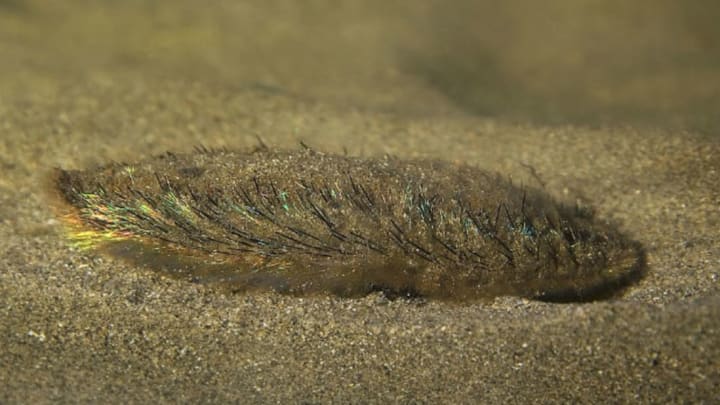Identifying a new genus or species is a pretty big deal. Like proud parents, scientists often give their discoveries the biggest, most impressive names they can think of.
1. SEA MOUSE (APHRODITA ACULEATA)
This furry sea worm was named for the Greek goddess of beauty and love by none other than Carl Linnaeus himself. Was the name a joke? Sort of—but not the one you’d think. By invoking Aphrodite, Linnaeus was actually commenting on the fact that a sea mouse at rest bears some resemblance to a lady’s genitals. Historians have noted that during Linnaeus’s time, “mouse” was also slang for “vagina.”
2. ARMADILLO LIZARD (OUROBOROS CATAPHRACTUS)
The mighty serpent Ouroboros is a classical symbol of infinity: holding its tail in its mouth, it forms a perfect circle with no beginning and no end. The armadillo lizard is somewhat less dignified. The little South African reptiles are covered in plates of spiny armor, and when threatened they bite their own tails and curl up, leaving potential predators with a ball of spikes. It’s an effective strategy. It’s also really, really cute.
3. MILLIPEDE (TASMANIOSOMA ANUBIS)
In early 2015, researchers reported that they had named a newly discovered species of millipede after the Egyptian god Anubis. The millipede, they said, was shaped like the jackal god’s head. Well, part of the millipede, anyway: From certain angles, you can just make out a jackal’s head in the shape of the male millipede’s gonopod telopodite, or sex organ.
4. THOR’S HERO SHREW (SCUTISOREX THORI)
It’s less than a foot long, but the Thor’s hero shrew is tough. Its power comes from its super-strong, interlocking spine, which lets the animal plunge into crevices of rock in search of worms. The gray-brown rodent is indeed a hero in its native Democratic Republic of the Congo, where the Mangbetu people evoke its invincibility by wearing portions of the animal as a talisman against weapons. The name “Thor” is actually a two-fer; the shrew was named for both the mighty Norse god and Thorvald “Thor” Holmes, Jr., a collections manager at the Humboldt State University Vertebrate Museum.
5. DEVIL FROG (BEEZELBUFO AMPINGA)

The devil frog is no longer with us, and that may be a good thing. This enormous prehistoric frog—possibly the largest frog that has ever lived—had a taste for meat, a predilection for ambushing its prey, and a big, big mouth. The scientists who discovered fossil evidence of the frog named it Beezelbufo ampinga, or “armored frog from hell.”
6. PARASITIC NEMATODE (GENUS CLOACINA)
There is a deity for everything. Cloacina was the Roman goddess of the sewers, particularly the Cloaca Maxima, or "Great Drain." She is rarely invoked these days, but her memory survives deep inside a kangaroo. There is an entire genus of nematodes that lives exclusively in the stomachs of kangaroos and wallabies, and each one bears the goddess’s name.
7. SACISAURUS
It’s extremely rare to find an intact dinosaur skeleton—most fossils that we have today were discovered in bits and pieces. Such is the case of the sacisaurus, a plant-eating dinosaur found in southern Brazil. The fossil was missing one leg, and so the research team named it for Saci, a one-legged prankster from Brazilian folklore. By all accounts, Saci is quite a nuisance; he steals children’s toys, sours milk, annoys dogs, and keeps popcorn from popping. There’s been no word yet as to whether the dinosaur did the same thing.
